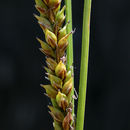Comprehensive Description
provided by North American Flora
Carex debiliformis Mackenzie, Bull. Torrey Club 37:244. 1910.
Carex cinnamomea Olney; A. Gray, Proc. Am. Acad. 8: 396. 1872. (Type from Mendocino County,
California.) Not C. cinnamomea Boott, 1846. "Carex mendocinensis Olney" Mackenzie, Krythea 8: 63, in part. 1922.
Clumps medium-sized, not stoloniferous, the rootstocks somewhat elongate, the culms 5-8 dm. high, very slender, nodding, much exceeding the leaves, aphyllopodic, obtusely triangular, smooth below the spikes, brownish-red at base; sterile shoots numerous, elongate, their culms well-developed; leaves with well-developed blades usually 3 or 4 to a fertile culm, widely separated, the blades erect, usually 5-12 cm. long, 1.75-2.5 mm. wide, flat toward apex, channeled toward base, the margins revolute, very sparsely hispidulous, pubescent near the base, deep-green, thin, roughened especially on the margins and toward the apex; sterile-culm leaves long-attenuate, much longer (1.5-3.5 dm. long); sheaths very long, very sparsely hispidulous dorsally, whitish-hyaline and brownish-tinged ventrally, the ligule longer than wide ; terminal spike staminate, or occasionally with one or two perigynia at base or little separate, long-peduncled, slender, linear, 1.5-3.5 cm. long, 2-3 mm. wide, the scales closely appressed, oblong-obovate, obtuse or acutish, cinnamon-brown with broad white-hyaline margins and lighter midvein; pistillate spikes 2 or 3, the lower at least strongly separate, the upper more or less so, the uppermost erect, short-peduncled or nearly sessile, the lower weakly erect, slenderpeduncled, slender, linear, 1.5-5 cm. long, 3.5-4.5 mm. wide, closely flowered above, loosely at base, the perigynia 20-50, appressed-ascending in few rows; bracts leaflet-like, the lowest with elongate smooth sheath 2-3 cm. long, and blade exceeding the spike, the upper with shorter blades and sheaths; scales ovate, sharply keeled, obtuse to cuspidate, minutely ciliate, sometimes sparingly appressed-pubescent, cinnamon-brown with lighter midvein and hyaline margins, one half to three fourths the length of and nearly as wide below as the perigynia; perigynia oblong-oblanceolate, 3.5 mm. long, 1.5 mm. wide, triangular or somewhat flattenedtriangular, glabrous, light-green, membranaceous, puncticulate, obscurely few-nerved, tapering at base and substipitate, abruptly contracted at apex into a hyaline bidentate beak 0.5 mm. long, short-ciliate at mouth, and sometimes sparingly appressed-pubescent above; achenes oblong-obovoid, 2.5 mm. long, 1.25 mm. wide, triangular with concave sides and blunt angles, closely enveloped, brownish, granular, slenderly but conspicuously rather short-stipitate, abruptly conspicuously apiculate, jointed with the short slender style; stigmas 3, slender, rather short.
Type locality (of C. cinnamomea Olney, on which C. debiliformis is based): Mendocino County, California (Bolander 6477).
Distribution: Swampy places, southwestern Oregon and northwestern California. (Specimens examined from southwestern Oregon; northwestern California.)
- bibliographic citation
- Kenneth Kent Mackenzie. 1935. (POALES); CYPERACEAE; CARICEAE. North American flora. vol 18(5). New York Botanical Garden, New York, NY
Comprehensive Description
provided by North American Flora
Carex mendocinensis Olney; W. Boott, in S. Wats Bot. Calif. 2: 249. 1880.
Clumps medium-sized, not stoloniferous, the rootstock somewhat elongate, the culms 2.5-8 dm. high, very slender, nodding, much exceeding the leaves, strongly aphyllopodic, rather obtusely triangular, smooth below the spikes, strongly purplish-red and scaly at the base; sterile shoots numerous, reduced to tufts of leaves, their culms not developed; leaves with well-developed blades about 7 to a culm, the lower clustered, the upper widely separated, the blades ascending, 5-10 cm. long, 3-5 mm. wide, flat with revolute margins, somewhat channeled toward base, dull-green, firm, rough-hispidulous on both sides, attenuate; sterileculm blades 1-3 dm. long; sheaths very long, hispidulous dorsally, whitish-hyaline and brownish-tinged ventrally, the ligule longer than wide; terminal spike staminate, or occasionally with one or two perigynia at base, sessile or very short-peduncled, slender, linear, 2-3.5 cm. long, 2.5-4 mm. wide, the scales closely appressed, oblong-obovate, obtuse or acutish, slightly ciliate, dull-reddish -brown with hyaline margins and lighter midvein; pistillate spikes 2 or 3, slender, erect, more or less strongly separate, the uppermost nearly sessile, nearly equaling the staminate spike, the lower peduncled, linear, 2-4 cm. long, 3-4.5 mm. wide, closely flowered above, loosely at base, the perigynia 20-40, appressed-ascending, in few rows; bracts leaf -like, the lowest with elongate hispidulous sheath 2-3 cm. long and blade nearly equaling the culm, the upper with shorter blades and sheaths; scales ovate, short-cuspidate to obtuse, sharply keeled, slightly ciliate, cinnamon-brown with green midrib and narrow hyaline margins, as wide as and one half to three fourths the length of the perigynia; perigynia oblong-oblanceolate, 4-5 mm. long, 1.5 mm. wide, triangular or somewhat flattened-triangular, oblong-obovate, glabrous below, minutely pubescent on angles toward apex, light-green, membranaceous, puncticulate, lightly few-nerved, tapering at base and substipitate, abruptly contracted at apex into a bidentate beak 0.5 mm. long, ciliate at mouth; achenes oblong-obovoid, 2.5 mm. long, 1.25 mm. wide, triangular with concave sides and blunt angles, closely enveloped, brownish, granular, slenderly but conspicuously rather short-stipitate, abruptly conspicuously apiculate, jointed with the short slender style; stigmas 3, slender, rather short.
Type locality: Mendocino County, California (Bolander 4701).
Distribution: Along streams in the coast ranges of Mendocino County, northwestern California. (Specimens examined showing range as given.)
- bibliographic citation
- Kenneth Kent Mackenzie. 1935. (POALES); CYPERACEAE; CARICEAE. North American flora. vol 18(5). New York Botanical Garden, New York, NY

